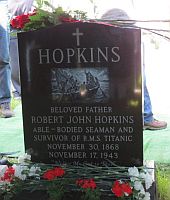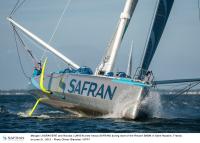 In December, we posted about a new breed of ocean racing sailboats with foiling daggerboards, which look somewhat like Salvador Dali’s moustache. Safron Sailing Team recently posted a video to explain how these foils work. From an engineering and design point of view, the new developments are fascinating. Whether movable foils, articulating keels, and the other wonderful but complex and expensive innovations on these offshore racing sleds will translate into usable technology for the average sailor remains to be seen.
In December, we posted about a new breed of ocean racing sailboats with foiling daggerboards, which look somewhat like Salvador Dali’s moustache. Safron Sailing Team recently posted a video to explain how these foils work. From an engineering and design point of view, the new developments are fascinating. Whether movable foils, articulating keels, and the other wonderful but complex and expensive innovations on these offshore racing sleds will translate into usable technology for the average sailor remains to be seen.
 Last week we made a post with the headline, HMS Victory ‘Collapsing’ Under Her Own Weight. The headline was alarmist at best. (We borrowed it from the BBC, but that is no excuse.) The historic ship will, of course, not be allowed to collapse under its own weight. David Hayes of the Historic Naval Fiction blog was kind enough to pass along this very interesting video about the engineering behind the 136 metal supports being installed to support, or as the video refers to it , “re-support,” HMS Victory to control the bulging and racking of the hull.
Last week we made a post with the headline, HMS Victory ‘Collapsing’ Under Her Own Weight. The headline was alarmist at best. (We borrowed it from the BBC, but that is no excuse.) The historic ship will, of course, not be allowed to collapse under its own weight. David Hayes of the Historic Naval Fiction blog was kind enough to pass along this very interesting video about the engineering behind the 136 metal supports being installed to support, or as the video refers to it , “re-support,” HMS Victory to control the bulging and racking of the hull.
Robert John Hopkins was one of the lesser-known heroes on the Titanic. He died in 1943 at the age of 77 and was buried in an unmarked grave in the Holy Name Cemetery, in Jersey City, NJ. Last Saturday, his descendants gathered to dedicate a black granite tombstone at his gravesite, 73 years after his death.
Able seaman Hopkins, a rigger by trade, and fireman Fred Barrett were assigned to Lifeboat 13 on the night of the sinking of the Titanic on April 15th, 1912. When the lifeboat was lowered, it drifted beneath Lifeboat 15, which was being lowered directly on top of them. Hopkins and Barrett jumped up and used their pocket knives to cut away the lifeboat falls which were holding their boat in the way of the lifeboat being lowered. They are credited with saving the lives of the more than 100 passengers in the two boats.
One of the passengers in Lifeboat 13 was Madeline Astor, the wife of John Jacob Astor IV, who died in the sinking. John Jacob Astor was believed to be the richest man aboard the Titanic and one of the richest men in the world at the time. Mrs. Astor had been the 18-year-old socialite Madeleine Talmage Force when she married the 47-year-old Astor in 1911. They were returning from an extended honeymoon when they boarded the Titanic. According to the Hudson Dispatch in 1943, “Later Mrs. Astor presented [Hopkins] with a purse for being instrumental in saving her life.”
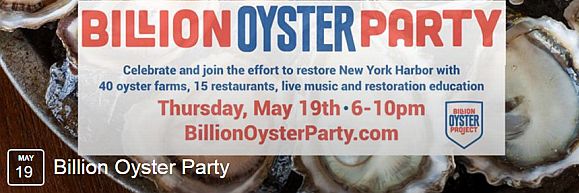 Next week is a great week for oysters if you are in the Northeast. Next Thursday is the Billion Oyster Party in Brooklyn, NY, while on Friday, the Newport Oyster Festival will be kicked off with an Opening Night Party at Bowen’s Wharf in Newport, RI.
Next week is a great week for oysters if you are in the Northeast. Next Thursday is the Billion Oyster Party in Brooklyn, NY, while on Friday, the Newport Oyster Festival will be kicked off with an Opening Night Party at Bowen’s Wharf in Newport, RI.
On Thursday night, May 19th, the Billion Oyster Project is hosting the Third Annual Billion Oyster Party in Brooklyn, NY. The party will feature oysters from 40 oyster farms from all over the U.S. from Washington to Louisiana to New York. The oysters from around the country each have their own delicate flavor and all of the farmers have stories to tell, as they shuck an estimated 20,000 oysters.

Photo: ©JEAN-MARIE LIOT / DPPI / MACIF
The finishers in the 2016 Transat bakerly single-handed trans-Atlantic race are now arriving in Brooklyn. This year’s winner, Francois Gabart on the 100′ trimaran MACIF, crossed the finish line on Wednesday, in the near record time of 8 days, 8 hours, 54-minutes and 39-seconds. The Transat bakerly began in 1960 as the OSTAR, the Observer Singlehanded Trans-Atlantic Race. The first race winner was Francis Chichester in Gypsy Moth III, who took 40 days, 12 hours and 30 minutes to complete the race.
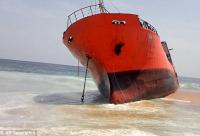 On May 4th, the 1441 DWT Panamanian registered product tanker Tamaya 1 drifted ashore on a remote beach in Liberia near Robertsport, with no crew aboard. There appears to have been a fire in the ship’s deckhouse and one of two lifeboats was missing. The vessel’s last known position was recorded on April 22, 2016, as the ship was steaming southward towards Senegal after leaving the port of Dakar. A statement from the Liberian Ministry Of National Defense read: ‘During the search on board the vessel, it was discovered that the abandoned vessel is an oil tanker and but so far no information was established regarding the number of crew members as no crew members were found on board … ‘It was further gathered by the Liberian Coast Guard (LCG) that the vessel was gutted by fire, leaving the bridge (Upper and Control Center) burned along with all documents’.
On May 4th, the 1441 DWT Panamanian registered product tanker Tamaya 1 drifted ashore on a remote beach in Liberia near Robertsport, with no crew aboard. There appears to have been a fire in the ship’s deckhouse and one of two lifeboats was missing. The vessel’s last known position was recorded on April 22, 2016, as the ship was steaming southward towards Senegal after leaving the port of Dakar. A statement from the Liberian Ministry Of National Defense read: ‘During the search on board the vessel, it was discovered that the abandoned vessel is an oil tanker and but so far no information was established regarding the number of crew members as no crew members were found on board … ‘It was further gathered by the Liberian Coast Guard (LCG) that the vessel was gutted by fire, leaving the bridge (Upper and Control Center) burned along with all documents’.
At this point, what happened to the ship and its crew is all speculation. The ship was operating well south of the region where pirate activity hs been reported. One source speculated about the involvement of Boku Haram. Some have suggested that the ship’s owner may have just gone broke and the crew simply abandoned the ship.
 Sailors have long considered Friday to be an unlucky day and Friday the 13th, particularly so. On this Friday the 13th, it seems appropriate to remember the unlikely tale of HMS Friday.
Sailors have long considered Friday to be an unlucky day and Friday the 13th, particularly so. On this Friday the 13th, it seems appropriate to remember the unlikely tale of HMS Friday.
Sometime in the 1800s, it is said that the Royal Navy decided to dispel the stigma attached to Friday. They commissioned a ship and named it the HMS Friday. Her keel was laid on a Friday, she was launched on a Friday, and she set sail on her maiden voyage on Friday the 13th, under the command of a Captain James Friday. She was never seen or heard from again.
While this is an oft-told tale, none of it is true. There has never been a Royal Navy ship named Friday, or any other day of the week, for that matter. HMS Ark Royal, on the other hand, was relaunched on Friday, June 13, 2001, following a major overhaul and continued successfully for another decade before she was decommissioned in 2011. Happy Friday the 13th.
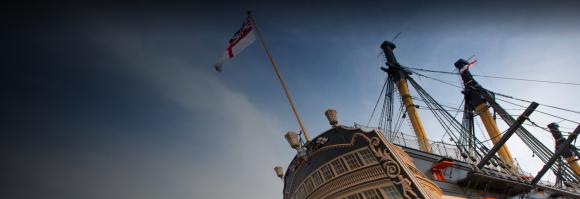 This week the BBC reported: Lord Nelson’s HMS Victory ‘collapsing’ under own weight. Sadly, this is not a new story. Five years ago we posted about an extremely similar account in the Telegraph: HMS Victory rotting and being pulled apart under its own weight. Last year we also posted: HMS Victory at 250 Years Old — Last Chance to Save the Historic Ship? The 250-year-old ship was never designed to sit high and dry in a drydock and is subject to rot and weathering like any wooden vessel.
This week the BBC reported: Lord Nelson’s HMS Victory ‘collapsing’ under own weight. Sadly, this is not a new story. Five years ago we posted about an extremely similar account in the Telegraph: HMS Victory rotting and being pulled apart under its own weight. Last year we also posted: HMS Victory at 250 Years Old — Last Chance to Save the Historic Ship? The 250-year-old ship was never designed to sit high and dry in a drydock and is subject to rot and weathering like any wooden vessel.
Fortunately, the problem is not being ignored. HMS Victory, Lord Nelson’s flagship in the Battle of Trafalgar in 1805, is undergoing a 13-year, £35m restoration. As part of the restoration, more than 130 metal supports are due to be fitted in the dry dock to stop the ship’s structure from deforming.
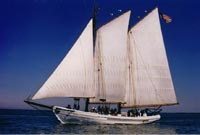 The crew aboard the schooner A.J. Meerwald had just finished a Saturday evening sail on the Delaware River near Trenton, NJ when they heard screams at around 7PM. They immediately launched a boat and headed in the direction of the screams toward a man in the river clinging to the bottom of an overturned personal watercraft, commonly known as a jet ski. The two Meerwald crew in the boat, Tom Nichols and Hudson Smith, hauled the man, who was not wearing a life jacket, aboard their boat from the cold river water.
The crew aboard the schooner A.J. Meerwald had just finished a Saturday evening sail on the Delaware River near Trenton, NJ when they heard screams at around 7PM. They immediately launched a boat and headed in the direction of the screams toward a man in the river clinging to the bottom of an overturned personal watercraft, commonly known as a jet ski. The two Meerwald crew in the boat, Tom Nichols and Hudson Smith, hauled the man, who was not wearing a life jacket, aboard their boat from the cold river water.
The man was able to tell them that his friend, 26-year-old Jesus Diaz Melendez of Trenton, was missing after their jet ski ran ashore. The Meerwald’s crew contacted the US Coast Guard who dispatched a 29-foot response boat crew as well as a helicopter crew. The Meerwald‘s boat also continued searching for Menedez for the next hour, to no avail. The Coast Guard called off the search that evening at around 11PM. Reports are that Menendez was also not wearing a life jacket when he went into the river.
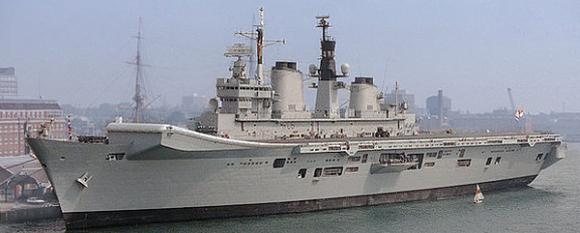 HMS Illustrious, the UK’s only working aircraft carrier and the last surviving ship from the Falklands War is to be scrapped. The 689 ft-long 22,000-tonne Invincible-class aircraft carrier traveled close to one million sea miles in her 32-year career with the Royal Navy, serving in conflicts from the Falklands to Bosnia and Iraq. She was decommissioned in 2014. Proposals to turn the ship into a floating museum or attraction space all fell through. Bids are reportedly being solicited to scrap the ship.
HMS Illustrious, the UK’s only working aircraft carrier and the last surviving ship from the Falklands War is to be scrapped. The 689 ft-long 22,000-tonne Invincible-class aircraft carrier traveled close to one million sea miles in her 32-year career with the Royal Navy, serving in conflicts from the Falklands to Bosnia and Iraq. She was decommissioned in 2014. Proposals to turn the ship into a floating museum or attraction space all fell through. Bids are reportedly being solicited to scrap the ship.
Great Britain has two new aircraft carriers under construction. The first, HMS Queen Elizabeth, is due to be commissioned in 2017 with initial operations in 2020. Thanks to Alaric Bond for contributing to this post.
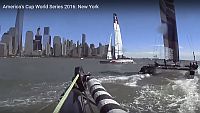 Sailing is all about technology and has been ever since the first sailor spread a stretched an animal skin as a sail. The America’s Cup, however, is far more technological than most sailing by a large measure. This thought occurred to me as I was sitting at a restaurant table with fourteen relatives and relations celebrating Mother’s Day, while also watching the second day of the New York Louis Vitton America’s Cup World Series, being sailed on lower Hudson River, on an app on my phone.
Sailing is all about technology and has been ever since the first sailor spread a stretched an animal skin as a sail. The America’s Cup, however, is far more technological than most sailing by a large measure. This thought occurred to me as I was sitting at a restaurant table with fourteen relatives and relations celebrating Mother’s Day, while also watching the second day of the New York Louis Vitton America’s Cup World Series, being sailed on lower Hudson River, on an app on my phone.
 I am a huge fan of the Bulwer-Lytton Fiction Contest. The contest is a whimsical literary competition that challenges entrants to compose the opening sentence to the worst of all possible novels. If you are not acquainted with Edward Bulwer-Lytton, he was the English novelist who in 1830 penned the classic first phrase to the first sentence of the novel Paul Clifford which begins: “It was a dark and stormy night …” In all fairness, Bulwer-Lytton gets a bad rap. He also coined other memorable phrases including “the great unwashed“, “pursuit of the almighty dollar“, and “the pen is mightier than the sword.” All the same, the contest is great fun.
I am a huge fan of the Bulwer-Lytton Fiction Contest. The contest is a whimsical literary competition that challenges entrants to compose the opening sentence to the worst of all possible novels. If you are not acquainted with Edward Bulwer-Lytton, he was the English novelist who in 1830 penned the classic first phrase to the first sentence of the novel Paul Clifford which begins: “It was a dark and stormy night …” In all fairness, Bulwer-Lytton gets a bad rap. He also coined other memorable phrases including “the great unwashed“, “pursuit of the almighty dollar“, and “the pen is mightier than the sword.” All the same, the contest is great fun.
Every year contestants attempt to pen opening sentences that are so bad that they are good, or if not good, at least amusing. Here are the winners with a nautical focus from this year’s contest.
Winner, Adventure:
After weeks at sea, Captain Fetherstonhaugh and his hardy crew had at last crossed the halfway point, and he mused that the closest dry land now lay in the Americas, assuming of course that it was not raining there. David Laatsch, Baton Rouge, LA
Runner-Up, Adventure:
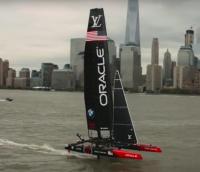 This afternoon, the Americas’ Cup will return to New York. Well, not the cup itself, and the races aren’t for the cup either. They are qualifying races for the big races next year. But they will be raced on super-fast AC45 foiling catamarans, that is if the wind on the Hudson River cooperates. So far, the weather folks are predicting winds of 2-4 knots at race time. The announced rules say that the race will not start in less than five knots of wind. There will be considerable pressure to start the race on time as it scheduled to be broadcast live at 2PM, by NBC in the US and by various other broadcasters around the world.
This afternoon, the Americas’ Cup will return to New York. Well, not the cup itself, and the races aren’t for the cup either. They are qualifying races for the big races next year. But they will be raced on super-fast AC45 foiling catamarans, that is if the wind on the Hudson River cooperates. So far, the weather folks are predicting winds of 2-4 knots at race time. The announced rules say that the race will not start in less than five knots of wind. There will be considerable pressure to start the race on time as it scheduled to be broadcast live at 2PM, by NBC in the US and by various other broadcasters around the world.
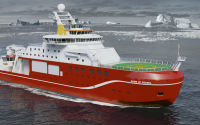 It is official. The polar research ship formerly known as Boaty McBoatface will be named RRS Sir David Attenborough. Despite an overwhelming number of suggestions that the UK’s new polar research ship be named Boaty McBoatface, the ship will be named after the world-renowned naturalist and broadcaster, who will soon be turning 90. Sir David said he was “truly honoured” by the decision. One of the new research vessel’s remotely operated vehicles (ROV) will however, be named “Boaty.”
It is official. The polar research ship formerly known as Boaty McBoatface will be named RRS Sir David Attenborough. Despite an overwhelming number of suggestions that the UK’s new polar research ship be named Boaty McBoatface, the ship will be named after the world-renowned naturalist and broadcaster, who will soon be turning 90. Sir David said he was “truly honoured” by the decision. One of the new research vessel’s remotely operated vehicles (ROV) will however, be named “Boaty.”
As we posted last March, the British Natural Environment Research Council (NERC) asked the public for suggestions for a name for the new polar research ship. James Hand, a former BBC presenter turned press officer, suggested Boaty McBoatface. Through the wonder of the internet, the suggestion caught on and overwhelmingly became the most popular suggestion, receiving over 120,000 suggestions. Shortly after Mr. Hand’s suggestion took off, the NERC website crashed from the volume of suggestions. Mr. Hand has since disavowed his suggestion.
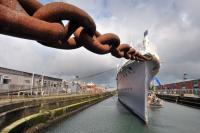 HMS Caroline, a decommissioned Royal Navy C-class light cruiser, is the last survivor of the Battle of Jutland, and one of only three surviving Royal Navy warships of the First World War. Now in Belfast, she has undergone a many million pound renovation and restoration to reflect her condition in 1916, when she served with the Grand Fleet in the Battle of Jutland, May 31 – June 1, 1916. Appropriately, she will be opening to the public as a museum ship and interpretive center on June 1st.
HMS Caroline, a decommissioned Royal Navy C-class light cruiser, is the last survivor of the Battle of Jutland, and one of only three surviving Royal Navy warships of the First World War. Now in Belfast, she has undergone a many million pound renovation and restoration to reflect her condition in 1916, when she served with the Grand Fleet in the Battle of Jutland, May 31 – June 1, 1916. Appropriately, she will be opening to the public as a museum ship and interpretive center on June 1st.
The renovation has included the installation of replica six-inch guns and torpedoes
Here is an animation of global ship traffic as seen from space. Mesmerizing and beautiful.
Global ship traffic seen from space – FleetMon Satellite AIS and FleetMon Explorer
Two thoughts immediately come to mind. Continue reading
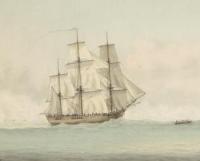 The news has been full of announcements about the discovery of Captain Cook’s HMS Endeavour by the Rhode Island Marine Archaeology Project (RIMAP) near the harbor at Newport, Rhode, Island. Much of the reporting has been somewhat confused. The Daily Mail, for example, provides a map which shows the location of the wreck as being in deep water in Rhode Island Sound generally between the Elizabeth Islands and Block Island, which doesn’t make any particular sense as the wreck is described as inside or near Newport harbor.
The news has been full of announcements about the discovery of Captain Cook’s HMS Endeavour by the Rhode Island Marine Archaeology Project (RIMAP) near the harbor at Newport, Rhode, Island. Much of the reporting has been somewhat confused. The Daily Mail, for example, provides a map which shows the location of the wreck as being in deep water in Rhode Island Sound generally between the Elizabeth Islands and Block Island, which doesn’t make any particular sense as the wreck is described as inside or near Newport harbor.
This seems oddly familiar. Haven’t we heard all this before? Continue reading
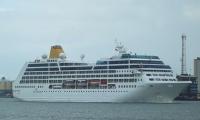 After more than a half-century, American cruise passengers have returned to Cuba. Carnival Corporation’s MV Adonia docked in Havanna, Cuba today carrying hundreds of Americans including a few dozen Cuban-born Americans returning to the island for the first time in decades. The arrival of the Cuban-born passengers had been a topic of some contention as a there is a Cuban regulation barring anyone born in Cuba from entering or leaving the Communist-ruled country by sea. Under pressure from the US, Cuba agreed to lift the ban.
After more than a half-century, American cruise passengers have returned to Cuba. Carnival Corporation’s MV Adonia docked in Havanna, Cuba today carrying hundreds of Americans including a few dozen Cuban-born Americans returning to the island for the first time in decades. The arrival of the Cuban-born passengers had been a topic of some contention as a there is a Cuban regulation barring anyone born in Cuba from entering or leaving the Communist-ruled country by sea. Under pressure from the US, Cuba agreed to lift the ban.
 The Draken Harald Hårfagre, the largest Viking longship in the world, is on her way, hopscotching across the Atlantic, to
The Draken Harald Hårfagre, the largest Viking longship in the world, is on her way, hopscotching across the Atlantic, to raid and plunder visit the United States this summer. After departing Haugesund, Norway and sailing for a day at sea, the longship had to put into Lerwick in the Shetland Islands to repair a broken shroud. The task was made significantly more difficult by modern electronics. Electronic cabling for antennas running down the backside of the mast complicated the repair. This is not the first time that the longship has diverted to Lerwick. In 2014, the put in to replace a broken mast.
The goal of the voyage is to explore one of the most legendary of all sea voyages – the Viking discovery of the New World. Draken Harald Hårfagre and her crew will sail for Iceland, Greenland and Newfoundland and then through the St. Lawrence Seaway to the Great Lakes before returning to the US East Coast in the late summer.
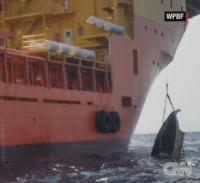 A 19-foot boat, which has been missing since last July, has been recovered in the Atlantic, restarting the saga of two families’ tragedy involving their two missing sons, lawyers, lawsuits, and suggestions of abduction and foul play.
A 19-foot boat, which has been missing since last July, has been recovered in the Atlantic, restarting the saga of two families’ tragedy involving their two missing sons, lawyers, lawsuits, and suggestions of abduction and foul play.
On Friday, July 28th, 2015, two fourteen-year-old boys, Austin Stephanos and Perry Cohen, headed out the Jupiter Inlet into the Atlantic Ocean in a 19-foot open boat powered by a single outboard motor. That afternoon there were reports of squalls and high winds. The boys did not return to the inlet that evening.

